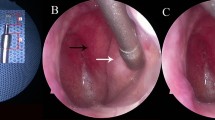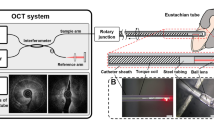Abstract
Objectives
To evaluate the technical feasibility of direct Eustachian tube catheterisation and subtraction Eustachian tubography in a cadaver model.
Methods
A total of 12 separate sessions were performed on both sides of the Eustachian tube (ET) in six human cadavers. Cadavers were positioned for the submentovertical view on a fluoroscopy table. Endoscopy-guided ET selection was used in the first three cadavers, whereas fluoroscopy-guided ET selection was used in the remaining three. Eustachian tubography was performed by injecting 2 ml of contrast media through a 5-Fr catheter. We recorded the success of ET selection, number of attempts, procedure time, and tubography quality using native and subtraction images (range, 0–3).
Results
Both endoscopy- and fluoroscopy-guided selections were successfully performed in five of six sessions (83.3%). There were no statistically significant differences between the endoscopy- and fluoroscopy-guided procedures in terms of the number of attempts, procedure time, rate of immediate contrast leak to the middle ear cavity, and quality of tubography (p > 0.05). An excellent quality of tubography was obtained in 83.3% (10 of 12 sessions) of subtraction images and in 33.3% (4 of 12 sessions) of native images. The tubography quality score was significantly higher for the subtraction images than for the native images (p = 0.04).
Conclusion
Subtraction Eustachian tubography using direct catheterisation seems to be technically feasible. The entire ET can be well visualised; thus, this technique can be used as a simple tool for assessment of ET function and anatomy.
Key Points
• Direct catheterisation of the Eustachian tube is technically feasible.
• The entire Eustachian tube could be well visualised by direct Eustachian tubography.
• Subtraction Eustachian tubography images have better image quality than native images.
• Subtraction Eustachian tubography can provide objective assessment of ET function and anatomy.



Similar content being viewed by others
Abbreviations
- ET:
-
Eustachian tube
References
Alper CM, Swarts JD, Singla A, Banks J, Doyle WJ (2012) Relationship between the electromyographic activity of the paratubal muscles and Eustachian tube opening assessed by sonotubometry and videoendoscopy. Arch Otolaryngol Head Neck Surg 138:741–746
Schilder AG, Bhutta MF, Butler CC et al (2015) Eustachian tube dysfunction: consensus statement on definition, types, clinical presentation and diagnosis. Clin Otolaryngol 40:407–411
Hwang SY, Kok S, Walton J (2016) Balloon dilation for Eustachian tube dysfunction: systematic review. J Laryngol Otol 130(Suppl 4):S2–S6
Huisman JML, Verdam FJ, Stegeman I, de Ru JA (2018) Treatment of Eustachian tube dysfunction with balloon dilation: a systematic review. Laryngoscope 128:237–247
McCoul ED, Anand VK (2012) Eustachian tube balloon dilation surgery. Int Forum Allergy Rhinol 2:191–198
McCoul ED, Anand VK, Christos PJ (2012) Validating the clinical assessment of eustachian tube dysfunction: the Eustachian Tube Dysfunction Questionnaire (ETDQ-7). Laryngoscope 122:1137–1141
Schroder S, Lehmann M, Sudhoff H, Ebmeyer J (2014) Assessment of chronic obstructive Eustachian tube dysfunction: evaluation of the German version of the Eustachian Tube Dysfunction Questionnaire. HNO 62:160 162-164
Van Roeyen S, Van de Heyning P, Van Rompaey V (2015) Value and discriminative power of the seven-item Eustachian Tube Dysfunction Questionnaire. Laryngoscope 125:2553–2556
Schroder S, Lehmann M, Korbmacher D, Sauzet O, Sudhoff H, Ebmeyer J (2015) Evaluation of tubomanometry as a routine diagnostic tool for chronic obstructive Eustachian tube dysfunction. Clin Otolaryngol 40:691–697
Kim KY, Tsauo J, Song HY et al (2017) Fluoroscopy-guided balloon dilation in patients with Eustachian tube dysfunction. Eur Radiol. https://doi.org/10.1007/s00330-017-5040-4
Wittenborg MH, Neuhauser EB (1963) Simple roentgeno-graphic demonstration of Eustachian tubes and abnormalities. Am J Roentgenol Radium Therapy, Nucl Med 89:1194–1200
Parisier SC, Khilnani MT (1970) The roentgenographic evaluation of Eustachian tubal function. Laryngoscope 80:1201–1211
Bluestone CD (1971) Eustachian tube obstruction in the infant with cleft palate. Ann Otol Rhinol Laryngol 80(Suppl 2):1–30
Gaafar H, el Deeb AK, Abdel-Baki F, el-Henawi D (1988) Flexible endoscopy and radiologic evaluation of the eustachian tube in adults with Eustachian tube dysfunction. Am J Otolaryngol 9:357–362
Funding
This study has received funding by Korea Health Technology R&D Project, Ministry for Health, Welfare and Family Affairs, Republic of Korea (HI17C0881).
Author information
Authors and Affiliations
Corresponding authors
Ethics declarations
Guarantor
The scientific guarantor of this publication is Ho-Young Song.
Conflict of interest
The authors of this manuscript declare no relationships with any companies, whose products or services may be related to the subject matter of the article.
Statistics and biometry
No complex statistical methods were necessary for this paper.
Informed consent
Written informed consent was not required for this study because this study is cadaveric experimental study.
Ethical approval
Institutional Review Board approval was not required because this study is a cadaveric experimental study.
Methodology
• Experimental study
• Performed at one institution
Rights and permissions
About this article
Cite this article
Kim, K.Y., Kang, W.S., Park, JH. et al. Fluoroscopic subtraction Eustachian tubography: initial feasibility test in a cadaver model. Eur Radiol 28, 3685–3691 (2018). https://doi.org/10.1007/s00330-018-5392-4
Received:
Revised:
Accepted:
Published:
Issue Date:
DOI: https://doi.org/10.1007/s00330-018-5392-4




